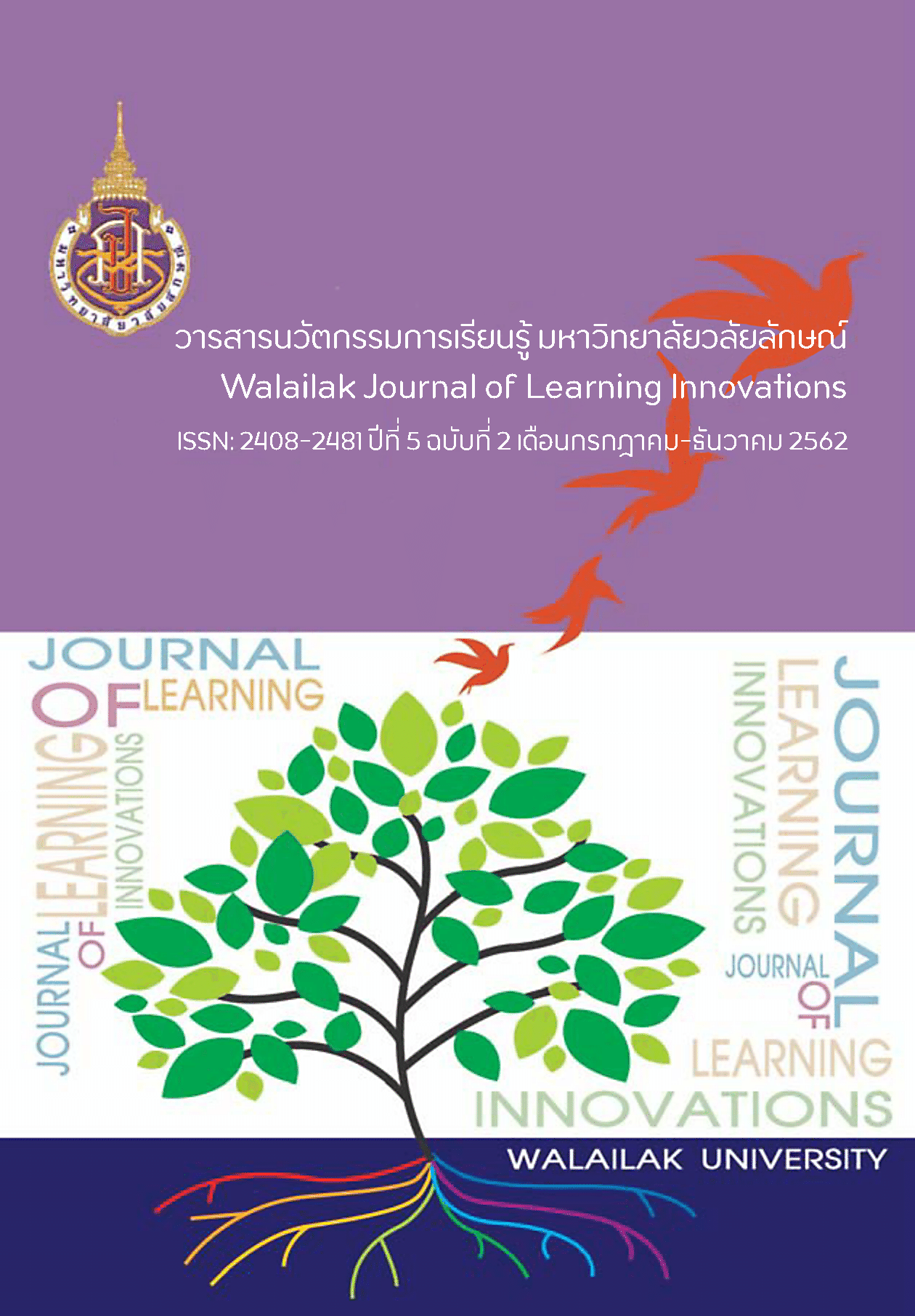The Decelopment of Computer Assited Instruction Based on Brain-Based Learning Theory on Topic: Types of Words In Thai Language For Prathom Suksa 5 Students.
DOI:
https://doi.org/10.14456/jli.2019.9Keywords:
Computer Assisted Instruction, Brain-Based Learning, Types of Words in Thai LanguageAbstract
The purposes of this research were 1) to develop the Computer Assisted Instruction (CAI) based on Brain-Based Learning (BBL) theory on topic: Types of Words in Thai Language for Prathom Suksa 5 Students, 2) to compare pretest-posttest students learning achievement with CAI, and 3) to study student’s satisfaction with CAI. The sample group was conducted under the purposive sampling technique and consisted of 26 in Prathom Suksa 5 students from Ban Nong Kham School (Khai Seni Uppatham), who were studying in second semester of the academic year 2018. The research tools included: 1) developed CAI based on BBL theory. 2) Learning achievement test which a multiple choice quizzes, 4 choices, 30 items 3) Sub chapters test which a multiple choice quizzes, 4 choices, 30 items and 4) student’s satisfaction rating scales 5 levels questionnaire for CAI, 10 items. Statistics used for data analyses were mean, percentage, standard deviation, Efficiency (E1/E2), and t-test dependent samples.
The results showed that: 1) the developed CAI had efficiency at 81.41/84.62. 2) The learning achievement had posttest score higher than pretest score at significant level .05 and 3) the satisfaction of sample groups also showed at high level (mean= 4.00, S.D. = 0.95)
References
Mana Sopa, Metta Chaitam and Patsaranit Khotmanee. (2016). kānphatthanā botrīan khō̜mphiutœ̄ chūai sō̜n samrap čhatkān rīanrū thī sō̜tkhlō̜ng kap kānthamngān khō̜ng samō̜ng rư̄ang kān būak lop lēk mai kœ̄n sō̜ng lak chan prathomsưksā pī thī sō̜ng [The Development of Computer Assisted Instruction Using Brain-based Learning Concept on Subject: Addition and Subtraction Less Than Two Digits Number for Prathom Suksa 2]. Journal of Srivanalai Vijai, 6(1), 164- 176.
Mana Sopa, Pornpimol Yoddongbang and Patcharin Pisaipan (2015). kānphatthanā botrīan khō̜mphiutœ̄ chūai sō̜n dōi chai nǣothāng kānčhatkān rīanrū thī sō̜tkhlō̜ng kap phatthanākān thāng samō̜ng (Brain - Based Learning: BBL) rư̄ang kān sakot kham chan prathomsưksā pī thī sām [The development of computer assisted instruction using Brain-Based Learning (BBL) approach on topic: The spelling words for Prathom Suksa 3]. Journal of Project in Computer Science and Information Technology, 3(2), 28-33.
Parkpoom Chaisiriprasert. (2009). kān phœ̄m prasitthiphāp kānnam sanœ̄ nư̄ahā khō̜ng sư̄ kānsō̜n ʻilekthrō̜nik phư̄a hai kœ̄t phon samrit nai kān rīanrū thāngkān sưksā [Increasing the efficiency of the presentation for electronic media materials in order to achievement learning]. Journal of Rangsit University: Teaching & Learning, 3(2), 64-67.
Pornpilai Lertwicha and Akraphum Charupaporn. (2007). ʻō̜k bǣp krabūankān rīanrū dōi khaočhai samō̜ng [Design learning processes by understanding the brain]. Bangkok: Darnsutha Press.
Royal Thai Government Gazette. (1999). phrarātchabanyat kānsưksā hǣng chāt Phō̜.Sō̜. 2542 [National Education Act B.E. 2542]. 116(74), 7.
Sudaporn Luksaneeyanawin. (2010). kān rīanrū sū kān plīanplǣng radap ʻudomsưksā [Transformative Higher Education Teaching and Learning]. Bangkok: Office of Higher Education Commission, Ministry of Education.
Surapol Eam-oo-sup. (2009). sō̜n yāngrai thī nēn phū rīan pen samkhan [How to student-centered teaching]. Bangkok: Dokya Press.
Taksina Wilailak. (2008). ʻō̜k bǣp botrīan [Lesson design]. Pathum Thani: Valaya Alongkorn Rajabhat University under the Royal Patronage.
Thepthidathip Wongthum. (2015). kānphatthanā botrīan khō̜mphiutœ̄ chūai sō̜n prakō̜p phǣnkān rīanrū hā E rư̄ang chanit khō̜ng kham Thai khō̜ng nakrīan chan prathomsưksā pī thī sī [The development of computer assisted instruction program in 5E learning on Thai parts of speech for prathomsuksa 4 students] (Master’s thesis). Maha Sarakham: Rajabhat Maha Sarakham University.
Downloads
Published
How to Cite
Issue
Section
License
เนื้อหาและข้อมูลในบทความที่ลงตีพิมพ์ในวารสารนวัตกรรมการเรียนรู้ มหาวิทยาลัยวลัยลักษณ์ ถือเป็นข้อคิดเห็นและความรับผิดชอบของผู้เขียนบทความโดยตรง ซึ่งกองบรรณาธิการวารสาร ไม่จำเป็นต้องเห็นด้วย หรือร่วมรับผิดชอบใดๆ
บทความ ข้อมูล เนื้อหา รูปภาพ ฯลฯ ที่ได้รับการตีพิมพ์ในวารสารนวัตกรรมการเรียนรู้ มหาวิทยาลัยวลัยลักษณ์ ถือเป็นลิขสิทธิ์ของวารสารนวัตกรรมการเรียนรุ้ มหาวิทยาลัยวลัยลักษณ์ หากบุคคลหรือหน่วยงานใดต้องการนำทั้งหมดหรือส่วนหนึ่งส่วนใดไปเผยแพร่ต่อเพื่อกระทำการใดๆ จ้อต้องได้รับอนุญาตเป็นลายลักษณ์อักษรจากวารสารนวัตกรรมการเรียนรู้ มหาวิทยาลัยวลัยลักษณ์ก่อนเท่านั้น


